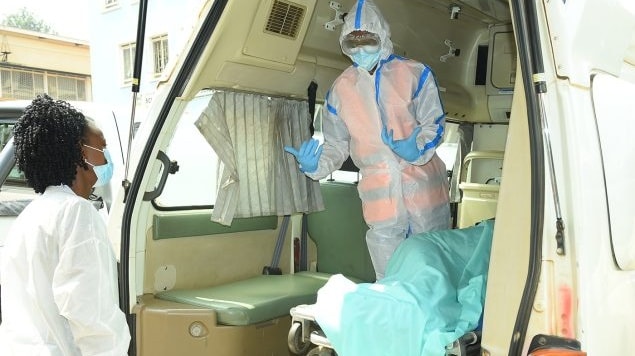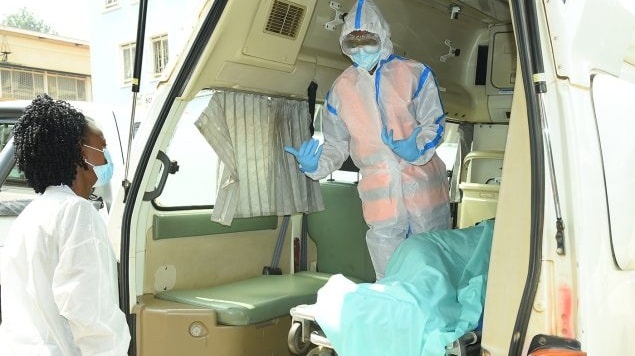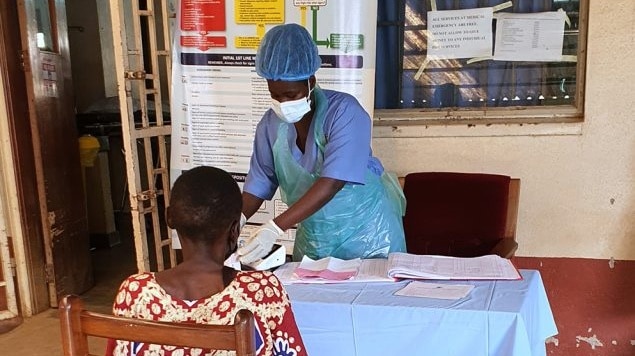Key points
With U.S. CDC's technical expertise and support, Uganda's Ministry of Health (MOH) and partners developed systems to vastly improve how patients were admitted to hospitals and clinics during COVID-19. Health workers were trained to quickly triage and prioritize treatment for patients. With CDC support, ambulances were equipped with supplies and fuel so more patients could be brought to health facilities.

The challenge
Long before COVID-19 spread around the globe, emergency care services in many low-and middle-income countries, including Uganda, were very limited. Most hospitals in Uganda only had basic emergency services.
If someone needed emergency medical care, it was not easy to contact an ambulance service due to availability. If an ambulance was available, the driver usually didn't have any medical training. The patient would often be taken to the hospital in a vehicle without any supplies or a paramedic. When the ambulance arrived at a hospital, most hospital staff were not trained to manage emergency conditions. In the few facilities that said they did triage patients, the process for doing so wasn't always the same.
Delayed arrival combined with a lack of a triage system to identify and treat critical patients often resulted in patients' deaths.

Gaps in emergency care
COVID-19 added more pressure on Uganda's emergency care system. Many healthcare facilities lacked medical equipment like blood pressure cuffs or pulse oximeters to read a patient's oxygen levels. Without these basic tools, seriously ill patients – who look healthy even as their bodies were starved of oxygen – were easily overlooked. With these challenges, there was an urgent need to train health workers to quickly triage and prioritize treatment for patients.
Improving emergency care triage
To address gaps and improve emergency medical services (EMS), the MOH and EMS team collaborated with Ugandan government facilities and universities, CDC, and other health organizations.
As a trusted partner, CDC sprang into action to improve triage for emergency care. With minimal resources, members from the MOH, CDC, and partners began supporting multiple levels of health facilities to improve emergency care.
"We were able to use our technical expertise, existing in-country programs, and emergency funding to support Uganda's MOH," says Boore.

CDC, Uganda's MOH and partners collaborated to create the Uganda Triage and Treatment Algorithm (UTAT). UTAT is an EMS training curriculum, with both adult and child options. CDC supported the development of the UTAT during a 3-day meeting with educators and emergency services partners led by the MOH. The final UTAT triage process was printed on posters that could be easily displayed at health facilities.
The new triage guidelines divide patients into three categories for treatment:
- "Red" patients are treated within 10 minutes of arrival.
- "Yellow" patients are treated within one hour.
- "Green" patients are treated after critical patients.
Working with the MOH and partners, CDC supported Uganda's first health worker training on how to use UTAT. CDC developed instructions for triaging and transferring patients and provided funding to six regional referral hospitals (RRH) in Uganda. This allowed each RRH to have a dedicated regional coordinator to manage the transfer of patients between facilities.
With CDC support, 18 phones, SIM cards, and minutes were bought for regional hospitals' EMS departments for successful communication between facilities. This allowed lower-level facilities to contact larger RRHs to confirm if they were able to treat a seriously ill patient.

Upgrading services
A well-coordinated emergency medical system needs ambulances and health facilities that provide appropriate care during and after the transfer of patients. Uganda needed more ambulances filled with life-saving supplies so patients could get adequate care when they needed it.
In Uganda, lack of fuel, limited ambulance drivers, and emergency medical technicians were some of the barriers to proper emergency care. CDC's support helped buy emergency fuel to ensure ambulances were operating where the need was greatest.
Building on successes
Uganda's improved EMS system is a testament to CDC, MOH and other partners working so well together to address common needs.
With CDC's technical and financial support, the MOH and partners continue to build on these EMS successes. Work continues to expand training sessions and triage implementation across the country. Partnerships are also on-going to improve life-saving medical care for all Ugandans during the COVID-19 pandemic and beyond.
